Topics
Category
Era
Liang May Seen (c.1871–1946)
Liang May Seen was the first woman of Chinese descent to live in Minnesota. After escaping from a brothel in San Francisco, she learned English, married, and moved to Minneapolis, where she was a leader in the Chinese immigrant community until her death in 1946.
Liang May Seen was born in southern China's Guandong Province around 1871. In 1885, when she was fourteen, her parents sold her to a man who promised that Liang would be marrying a wealthy Chinese American merchant. Instead, he sold her to a brothel in San Francisco.
At the brothel, Liang May Seen was forced to do sex work, but she planned her escape. She contacted the Presbyterian Mission Home for assistance. On July 21, 1889, she slipped away from a banquet and was picked up in a carriage sent by the mission.
Liang May Seen lived at the Mission Home for three years. Besides converting to Christianity and learning housekeeping skills, she took classes in English, Cantonese, and mathematics. In 1892, a Chinese businessman from Minneapolis, Woo Yee Sing, visited the mission looking for a wife. There he found Liang May Seen; they were married that summer, and she moved with him to Minneapolis.
Woo Yee Sing had immigrated to the United States at the age of eighteen, moving to San Francisco in the early 1880s. He arrived to face severe anti-Chinese violence. The 1882 Chinese Exclusion Act—which restricted Chinese immigration to the United States—had also bolstered the segregation and social exclusion of Chinese immigrants already in the United States.
Most of the Chinese men who came to the Midwest during the 1880s and 1890s moved from the West Coast to escape this kind of violence. Woo Yee Sing moved for the same reason. Minnesota was not free from violence or discrimination, however. In 1912 a small bomb was set off near his restaurant, and his son later recalled being taunted and called racist names.
Like many Chinese men at this time, Woo Yee Sing became a laundry operator. In 1883, he and his brother Woo Du Sing opened a restaurant. Canton Cafe, later known as John's Place, was the first Chinese restaurant in Minneapolis.
When Liang May Seen joined herhusband in Minneapolis, she was the first Chinese woman to live in Minnesota. She made friends quickly. Because of her time at the Mission Home, she was fluent in English and had experience with cross-cultural friendships. Many of the white women she befriended in Minneapolis were neighbors and patrons of the curio shop she opened in 1904. Others, such as suffragist Mabeth Hurd Paige, were friends through organizations like the Women's Foreign Missionary Society.
Liang May Seen and Woo Yee Sing were both involved with the Westminster Presbyterian Church. The church and its Chinese Sunday School were important institutions for many Chinese immigrants in Minneapolis. Westminster began teaching English lessons to Chinese men in 1882, and Woo Yee Sing was one of their first students. Although Westminster did not begin teaching English to Chinese women until 1920, the church was one of few places where women—both white and Chinese—could take on leadership roles through their involvement with social and religious activities. Most other civic organizations did not accept Chinese Americans until the 1930s or 1940s.
The Chinese community in Minneapolis began growing after 1900. As Minnesota's Chinese men achieved economic success, more of them were able to bring their wives and families from Guangdong Province. When Chinese women moved to Minneapolis, Liang May Seen was there to help them acclimate to their new country.
One of these women, Minnie Wong, became lifelong friends with Liang May Seen. Minnie Wong came to Minneapolis in the early 1900s to join her husband, Wong Gee. Liang May Seen and Minnie Wong were both from Kaiping District, and they spoke the same dialect. They visited each other frequently, and together they taught Westminster's first English classes for women.
In 1906, Liang May Seen and her husband expanded their family. They were never able to have biological children, but they adopted a young boy named Howard from San Francisco. Liang was also very close to her niece, Margaret Woo Chinn.
Liang May Seen passed away in 1946. She lived long enough to see the 1943 end of immigration laws excluding the Chinese.
Bibliography
Fuller, Sherri Gebert. Chinese in Minnesota. St. Paul: Minnesota Historical Society Press, 2004.
Holmquist, June Drenning, ed. They Chose Minnesota: A Survey of the State's Ethnic Groups. St. Paul: Minnesota Historical Society Press, 1981.
Mason, Sarah Refo. "Liang May Seen and the Early Chinese Community in Minneapolis." Minnesota History 54, no.5 (Spring 1995): 223–233.
http://collections.mnhs.org/MNHistoryMagazine/articles/54/v54i05p223-233.pdf
Minnesota Governor's Interracial Commission. The Oriental in Minnesota, a Report to Governor Luther W. Youngdahl. St. Paul, 1949.
Related Resources
Primary
Minnesota Ethnic History Project Records, 1969–1982
Manuscripts Collection, Minnesota Historical Society, St. Paul
http://www.mnhs.org/library/findaids/00260.xml
Description: Research and administrative material created by the Minnesota Ethnic History Project (MEHP) from 1973 to 1981, which culminated in the publication of the book They Chose Minnesota: A Survey of the State's Ethnic Groups. Box 20 contains folders for Howard Woo, Liang's son, and Margaret Woo Chinn, Liang's niece.
Sarah R. Mason Research Papers on Chinese in Minnesota, 1879–1999 (bulk 1978–1995)
Manuscripts Collection, Minnesota Historical Society, St. Paul
http://www.mnhs.org/library/findaids/00840.xml
Description: Research papers on Chinese, Hmong, and other Asians in Minnesota of Sarah R. Mason. The box "Chinese in Minnesota, 1879-1995" contains numerous folders pertaining to Liang May Seen, her son Howard Woo, and their family.
OH 51
Asians in Minnesota Oral History Project, 1978–1982: Interview with Howard Woo
Oral History Collection, Minnesota Historical Society, St. Paul
http://collections.mnhs.org/cms/display.php?irn=10395108
Description: Oral history interview with Howard F. Woo by Sarah R. Mason in St. Paul, Minnesota on October 9, 1981. Woo is Liang May Seen's son and discusses his mother. Full transcript is available online; cassettes are available at the MHS library; and more information is available in the Minnesota Ethnic History Project (see above).
OH 51
Asians in Minnesota Oral History Project, 1978–1982: Interview with Margaret Woo Chinn
Oral History Collection, Minnesota Historical Society, St. Paul
http://collections.mnhs.org/cms/display.php?irn=10191515
Description: Oral history interview with Margaret Woo Chinn by Sarah R. Mason in St. Paul, Minnesota on May 27, 1982. Chinn is Liang May Seen's niece and discusses her aunt. Full transcript is available online; cassettes are available at the MHS library; and more information is available in the Minnesota Ethnic History Project (see above).
OH 51
Asians in Minnesota Oral History Project, 1978–1982: Interview with Jane Wilson
Oral History Collection, Minnesota Historical Society, St. Paul
http://collections.mnhs.org/cms/display.php?irn=10447450
Description: Oral history interview with Lucia Jane Wilson by Sherri Gebert Fuller in Waseca, Minnesota on October 11, 2002. Wilson discusses Liang May Seen in the context of her work as superintendent of the Westminster Presbyterian Church's Chinese Sunday School. Full transcript is available online; cassettes are available at the MHS library; and more information is available in the Minnesota Ethnic History Project (see above).
Secondary
Bushnell, John Edward. The History of Westminster Presbyterian Church of Minneapolis, Minnesota, 1907–1937. Minneapolis: Lund Press, Inc., 1938.
Fuller, Sherri Gebert. "Mirrored Identities: The Moys of St. Paul." Minnesota History 57, no.4 (Winter 2000–2001): 162–181.
http://collections.mnhs.org/MNHistoryMagazine/articles/57/v57i04p162-181.pdf
Huie, Wing Young. Chinese-ness: The Meanings of Identity and the Nature of Belonging. St. Paul: Minnesota Historical Society Press, 2018.
Stuart, Bonnye E. More than Petticoats: Remarkable Minnesota Women. Guilford, CT: TwoDot, 2004.
Related Images
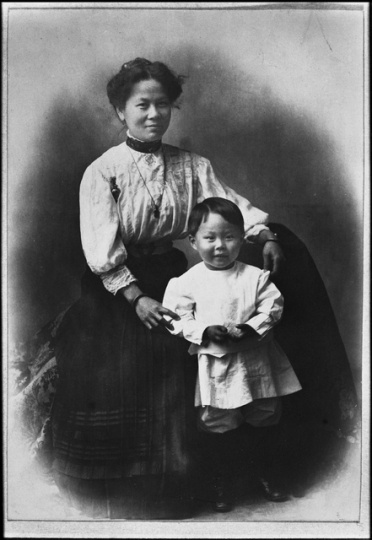
Liang May Seen with her son, Howard
Public domain
Holding Location
More Information
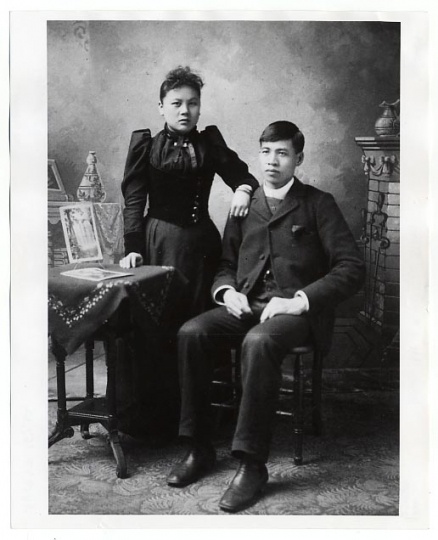
Liang May Seen and Woo Yee Sing while on their honeymoon at the Columbia Exposition in Chicago, Illinois.
Public domain
Holding Location
Articles
More Information
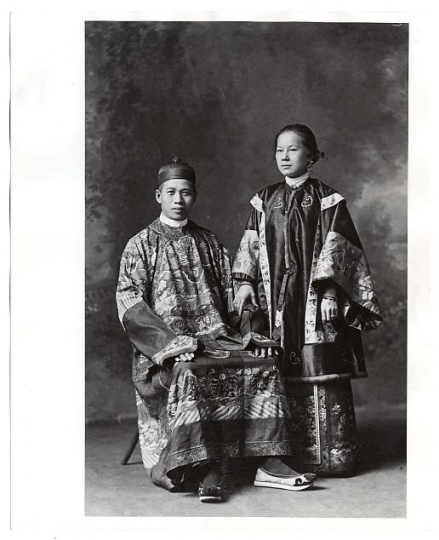
Wedding portrait of Woo Yee Sing and Liang May Seen
Public domain
Holding Location
Articles
More Information
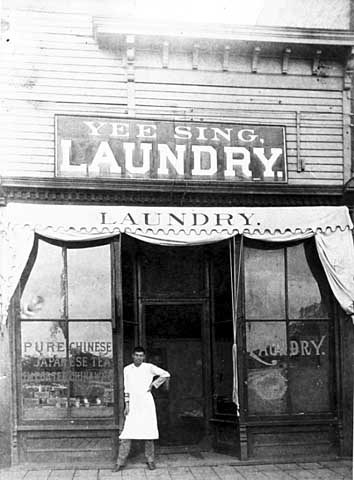
Yee Sing Woo standing in front of Yee Sing Laundry, 1319 Nicollet, Minneapolis
Public domain
Holding Location
Articles
More Information
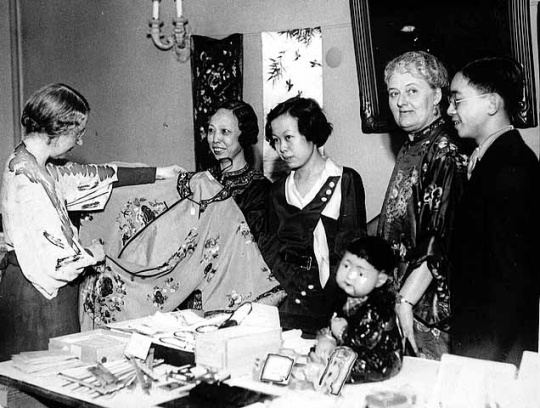
Chinese Bazaar at Westminster Presbyterian Church, Minneapolis
Holding Location
Articles
More Information
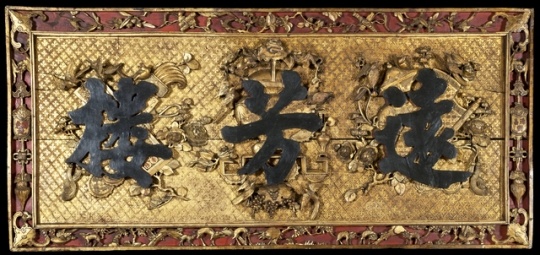
Sign for Yuen Faung Lo (John's Place) Chinese restaurant
All rights reserved
Holding Location
Articles
More Information
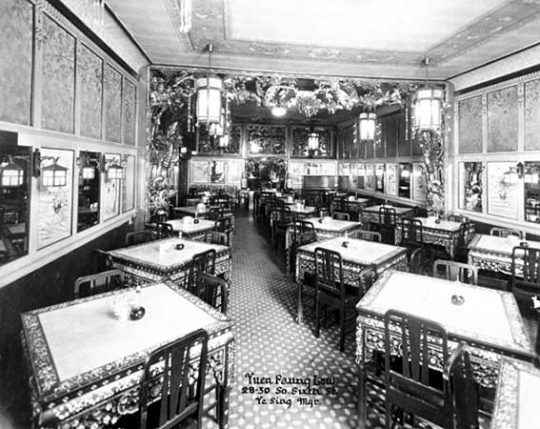
Interior of Yuen Faung Low (John's Place)
All rights reserved
Holding Location
Articles
More Information
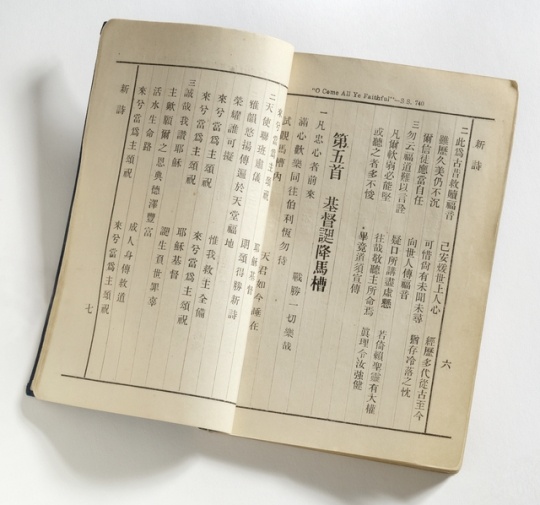
Hymnal used at Westminster Chinese Sunday School
All rights reserved
Holding Location
Articles
More Information
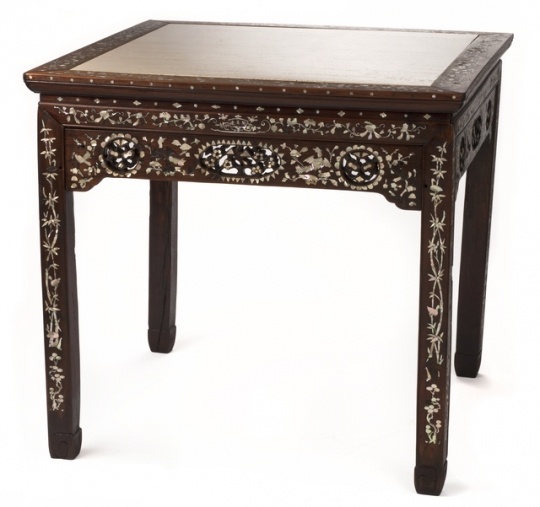
Table used at Yuen Faung Low (John's Place)
All rights reserved
Holding Location
Articles
More Information
Related Articles
Turning Point
In 1893, Liang May Seen moves to Minneapolis with her new husband, Woo Yee Sing. She is the first Chinese woman to live in Minnesota, and she becomes a friend and leader to Chinese women who arrive in Minneapolis in the following decades.
Chronology
1871
1880
1882
1885
1889
1892
1904
1906
1912
1920
1925
1946
Bibliography
Fuller, Sherri Gebert. Chinese in Minnesota. St. Paul: Minnesota Historical Society Press, 2004.
Holmquist, June Drenning, ed. They Chose Minnesota: A Survey of the State's Ethnic Groups. St. Paul: Minnesota Historical Society Press, 1981.
Mason, Sarah Refo. "Liang May Seen and the Early Chinese Community in Minneapolis." Minnesota History 54, no.5 (Spring 1995): 223–233.
http://collections.mnhs.org/MNHistoryMagazine/articles/54/v54i05p223-233.pdf
Minnesota Governor's Interracial Commission. The Oriental in Minnesota, a Report to Governor Luther W. Youngdahl. St. Paul, 1949.
Related Resources
Primary
Minnesota Ethnic History Project Records, 1969–1982
Manuscripts Collection, Minnesota Historical Society, St. Paul
http://www.mnhs.org/library/findaids/00260.xml
Description: Research and administrative material created by the Minnesota Ethnic History Project (MEHP) from 1973 to 1981, which culminated in the publication of the book They Chose Minnesota: A Survey of the State's Ethnic Groups. Box 20 contains folders for Howard Woo, Liang's son, and Margaret Woo Chinn, Liang's niece.
Sarah R. Mason Research Papers on Chinese in Minnesota, 1879–1999 (bulk 1978–1995)
Manuscripts Collection, Minnesota Historical Society, St. Paul
http://www.mnhs.org/library/findaids/00840.xml
Description: Research papers on Chinese, Hmong, and other Asians in Minnesota of Sarah R. Mason. The box "Chinese in Minnesota, 1879-1995" contains numerous folders pertaining to Liang May Seen, her son Howard Woo, and their family.
OH 51
Asians in Minnesota Oral History Project, 1978–1982: Interview with Howard Woo
Oral History Collection, Minnesota Historical Society, St. Paul
http://collections.mnhs.org/cms/display.php?irn=10395108
Description: Oral history interview with Howard F. Woo by Sarah R. Mason in St. Paul, Minnesota on October 9, 1981. Woo is Liang May Seen's son and discusses his mother. Full transcript is available online; cassettes are available at the MHS library; and more information is available in the Minnesota Ethnic History Project (see above).
OH 51
Asians in Minnesota Oral History Project, 1978–1982: Interview with Margaret Woo Chinn
Oral History Collection, Minnesota Historical Society, St. Paul
http://collections.mnhs.org/cms/display.php?irn=10191515
Description: Oral history interview with Margaret Woo Chinn by Sarah R. Mason in St. Paul, Minnesota on May 27, 1982. Chinn is Liang May Seen's niece and discusses her aunt. Full transcript is available online; cassettes are available at the MHS library; and more information is available in the Minnesota Ethnic History Project (see above).
OH 51
Asians in Minnesota Oral History Project, 1978–1982: Interview with Jane Wilson
Oral History Collection, Minnesota Historical Society, St. Paul
http://collections.mnhs.org/cms/display.php?irn=10447450
Description: Oral history interview with Lucia Jane Wilson by Sherri Gebert Fuller in Waseca, Minnesota on October 11, 2002. Wilson discusses Liang May Seen in the context of her work as superintendent of the Westminster Presbyterian Church's Chinese Sunday School. Full transcript is available online; cassettes are available at the MHS library; and more information is available in the Minnesota Ethnic History Project (see above).
Secondary
Bushnell, John Edward. The History of Westminster Presbyterian Church of Minneapolis, Minnesota, 1907–1937. Minneapolis: Lund Press, Inc., 1938.
Fuller, Sherri Gebert. "Mirrored Identities: The Moys of St. Paul." Minnesota History 57, no.4 (Winter 2000–2001): 162–181.
http://collections.mnhs.org/MNHistoryMagazine/articles/57/v57i04p162-181.pdf
Huie, Wing Young. Chinese-ness: The Meanings of Identity and the Nature of Belonging. St. Paul: Minnesota Historical Society Press, 2018.
Stuart, Bonnye E. More than Petticoats: Remarkable Minnesota Women. Guilford, CT: TwoDot, 2004.










